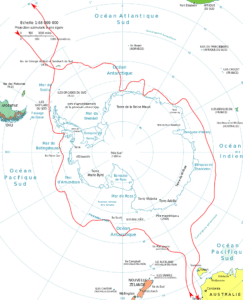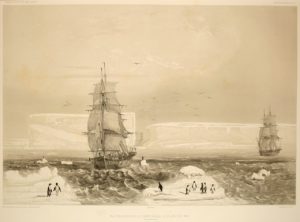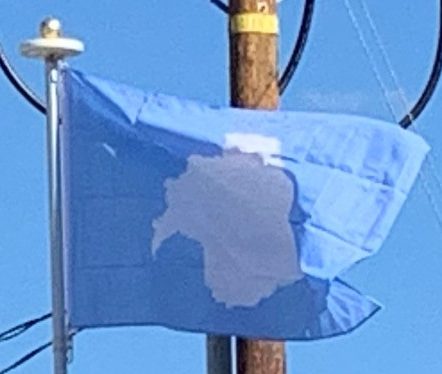According to various organizations (the National Science Foundation, NASA, the University of California, San Diego, the Russian State Museum of the Arctic and Antarctic, among others), ships captained by three men sighted Antarctica or its ice shelf in 1820: Fabian Gottlieb von Bellingshausen (a captain in the Imperial Russian Navy), Edward Bransfield (a captain in the Royal Navy), and Nathaniel Palmer (a sealer from Stonington, Connecticut).
The First Russian Antarctic Expedition led by Bellingshausen and Mikhail Lazarev on the 985-ton sloop-of-war Vostok (“East”) and the 530-ton support vessel Mirny (“Peaceful”) reached a point within 20 miles of Queen Maud’s Land and recorded the sight of an ice shelf at 69°21′28″S 2°14′50″W, on 27 January 1820, which became known as the Fimbul ice shelf. This happened three days before Bransfield sighted land and ten months before Palmer did so in November 1820. The first documented landing on Antarctica was by the American sealer John Davis, apparently at Hughes Bay, near Cape Charles, in West Antarctica on 7 February 1821, although some historians dispute this claim. The first recorded and confirmed landing was at Cape Adair in 1895 (by the Norwegian-Swedish whaling ship Antarctic).

On 22 January 1840, two days after the discovery of the coast west of the Balleny Islands, some members of the crew of the 1837–40 expedition of Jules Dumont d’Urville disembarked on the highest islet of a group of rocky islands about 4 km from Cape Géodésie on the coast of Adélie Land where they took some mineral, algae, and animal samples, erected the French flag and claimed French sovereignty over the territory.

In December 1839, as part of the United States Exploring Expedition of 1838–42 conducted by the United States Navy (sometimes called the “Ex. Ex.”, or “the Wilkes Expedition”), an expedition sailed from Sydney, Australia, into the Antarctic Ocean, as it was then known, and reported the discovery “of an Antarctic continent west of the Balleny Islands” on 25 January 1840. That part of Antarctica was named “Wilkes Land“, a name it retains to this day.
Explorer James Clark Ross passed through what is now known as the Ross Sea and discovered Ross Island (both of which were named after him) in 1841. He sailed along a huge wall of ice that was later named the Ross Ice Shelf. Mount Erebus and Mount Terror are named after two ships from his expedition: HMS Erebus and Terror. Mercator Cooper landed in East Antarctica on 26 January 1853.
During the Nimrod Expedition led by Ernest Shackleton in 1907, parties led by Edgeworth David became the first to climb Mount Erebus and to reach the South Magnetic Pole. Douglas Mawson, who assumed the leadership of the Magnetic Pole party on their perilous return, went on to lead several expeditions until retiring in 1931. In addition, Shackleton and three other members of his expedition made several firsts in December 1908 – February 1909: they were the first humans to traverse the Ross Ice Shelf, the first to traverse the Transantarctic Mountains (via the Beardmore Glacier), and the first to set foot on the South Polar Plateau.
